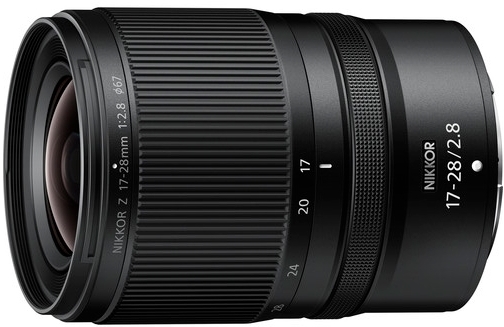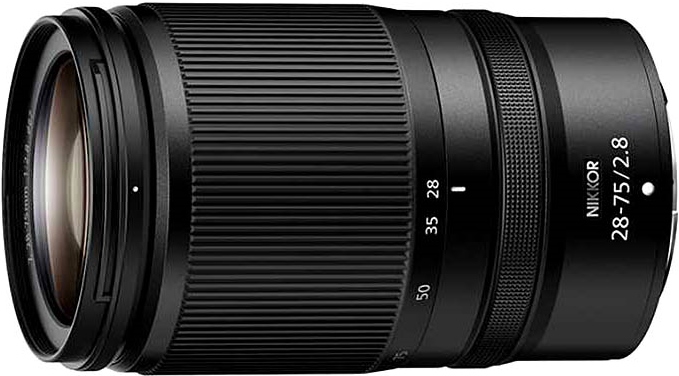Affordable optics kit for Nikon Z mirrorless cameras

A detailed comparison of the characteristics of the models from the review is given in the summary table of the available optics kit for Nikon Z mirrorless cameras. You can select the lens yourself in the corresponding section of the catalog. And the article of the same name will help you get acquainted with the “Marking of Nikon Lenses”.

To match the retro Nikon Z fc camera, a compact 28mm f/2.8 lens was also released. With a thickness of 43 mm and a diameter of 71.5 mm, you can easily carry it in your pocket, and the model weighs only 155 g. The prime is supposed to be used with a guard of full-frame and cropped Nikon Z cameras.
At full frame, the Nikon Nikkor Z 28mm f/2.8 is optimal for shooting landscapes and general plans; at crop, it is suitable for diverse scenes with a natural perspective of the frame. The model's aperture is not the most outstanding (f/2.8), but the lens is quite capable of blurring the background well when shooting with a shallow depth of field.
The optical design of the fix included 9 elements in 8 groups with two aspherical lenses. There was also a place in the body for a stepper autofocus drive - the lens is focused from a distance of 19 cm(relative to the focal plane of the camera matrix). It is allowed to attach filters with a diameter of 52 mm to the front frame of the model.
Of the control elements in the lens, there is only one ring, which is standardly used for manual sharpening. From the camera menu, the wheel function can be reassigned to change the aperture, light sensitivity or frame exposure correction. A similar design feature is typical for many “native” lenses for the Nikon Z system—the model in question was no exception.

| Justbuy.com.ua | 23 590 ₴ | To Store |
| Hi-Res Store Online | 36 759 ₴ | To Store |
| Stylus.ua | 27 999 ₴ | To Store |
| Touch | 26 999 ₴ | To Store |
| Цифра | 26 999 ₴ | To Store |
The first sign of the portrait league of optics for the Nikon Z mount “flew out of the nest” in 2019. This is a classic 85mm prime with f/1.8 aperture and a 9-blade aperture design. The model should be considered as an affordable portrait lens, which cannot be said about the more advanced but expensive Nikon Nikkor Z 85mm f/1.2 S lens.
The focus of the lens in question for portrait photography is manifested by the spectacular blurring of the background, which can be achieved with open apertures. At the same time, small objects in the blur zone turn into smooth discs that are pleasing to the eye, thus creating soft and beautiful bokeh. And the main thing is that already from an aperture of f/1.8 the prime lens paints a razor-sharp picture.
The optical formula of the model according to the scheme “12 elements in 9 groups” provides for two ED lenses made of low-dispersion glass, which are placed on guard to eliminate aberrations. The lens also uses anti-reflective lens coating Nano Crystal Coat. As for the other “internals,” it would be a shame not to mention the fast and silent ultrasonic autofocus drive with a target aiming distance of 80 cm.
Like many of its peers in the system, the lens has a customizable electronic ring. In addition to manual focusing, it can be used to change the aperture or exposure compensation, which is set through the camera menu. The model has no serious drawbacks and definitely deserves attention from owners of full-frame cameras of the Nikon Z system. And together with cropped mirrorless cameras for the same mount, the lens can be used in the role of a long-focus portrait photographer with an equivalent focal length of 127.5 mm.

| Justbuy.com.ua | 45 690 ₴ | To Store |
| KT-group.ua | 43 700 ₴ | To Store |
| Stylus.ua | 49 496 ₴ | To Store |
| Touch | 44 869 ₴ | To Store |
| Цифра | 48 963 ₴ | To Store |
Nikon's portfolio includes several wide-angle zoom lenses with constant aperture. This is the flagship model 14-24mm f/2.8 S, a simpler option 14-30mm f/4 S and a cheaper zoom 17-28mm f/2.8. We will consider the last instance in more detail.
The model is unlikely to be able to please with an ultra-wide field of view, but the range of 17-28 mm is usually quite enough for landscape, interior and architectural photography. In addition, one of the advantages of the lens is the constant f/2.8 aperture throughout the entire zoom range - coupled with the 9-blade aperture design, when shooting close-ups, there is an option to get spectacular background blur.
Oddly enough, the optical “formula” of the lens is one-to-one borrowed from the Tamron 28-75mm f/2.8 Di III RXD. It contains 13 elements in 11 groups with three aspherical, two ultra-low dispersion and one ED lens. The model's zooming and focusing are internal - the Nikon Nikkor Z 17-28mm f/2.8 does not change in size and does not shift its center of gravity, which is useful in video shooting mode with a stabilizer. A stepper STM motor is responsible for autofocusing the lens.
According to the new tradition , the zoom lens is equipped with a reprogrammable ring on the body. By default, it is assigned the function of manual focusing, but it can be changed to aperture, ISO adjustment or exposure compensation. The diameter for filters on the model is 67 mm, moreover, it coincides with that of its “relative” 28-75mm f/2.8, which is convenient when frequently rearranging lenses. As a bonus, the wide-angle zoom has a dust- and moisture-proof housing. Finally, it is worth mentioning the use of the lens with Nikon Z DX format cameras - the model transforms into a wide-angle with an equivalent field of view of about 25-42 mm.
| Justbuy.com.ua | 35 890 ₴ | To Store |
| KT-group.ua | 34 650 ₴ | To Store |
| Stylus.ua | 43 851 ₴ | To Store |
| Touch | 37 599 ₴ | To Store |
| Цифра | 43 416 ₴ | To Store |
A model with a set of focal lengths of 28-75 mm and a constant aperture throughout the entire f/2.8 zoom range is ideal for the role of a standard everyday zoom for mirrorless cameras of the Nikon Z system.
The lens turned out to be very compact and lightweight for a high-aperture multi-purpose “station wagon”. The dimensions of its body are 75x121 mm, and its weight is 565 g. Filters with a diameter of 67 mm can be installed on the front lens of the model. The closest analogue of this zoom is the Nikon Nikkor Z 24-70mm f/2.8 S - a large and expensive premium model. However, it has a price tag that is actually twice as much.
The lens in question is inferior to its counterpart by four millimeters of focal length in the wide-angle position. However, when working with medium and close-ups, the lack of viewing angle is not felt at all, but for shooting landscapes and interiors it is still better to get wider-angle optics. At the long end, the model allows you to get five additional millimeters of focal length. The f/2.8 aperture remains working for the model throughout the entire zoom range, except that at open apertures the picture may be slightly spoiled by vignetting (corrected in post-production) and a drop in sharpness at the edges of the frame. It is enough to close down to about f/4 and the problems are eliminated.
Structurally, the lens has an optical design of 15 elements in 12 groups, including three aspherical lenses and one Super ED element. The abundance of “aspherics” can provoke imperfect bokeh, but for a universal zoom, slight blur heterogeneity is quite acceptable. Also nestled inside the lens is a stepper motor for the automatic focusing system, which provides fast and silent autofocus (from 19 cm at wide angle and from 39 cm at telephoto zoom).
The outer part of the model's body has zoom and manual focus rings. The last ring can be reprogrammed from the camera menu to other functions - aperture, changing ISO or exposure compensation. The lens is intended to be used both with full-frame Nikon Z mirrorless cameras and with cropped cameras - in the version with APS-C sensors, the zoom provides coverage of equivalent focal lengths from approximately 42 to 112.5 mm.

| Justbuy.com.ua | 48 590 ₴ | To Store |
| KT-group.ua | 48 500 ₴ | To Store |
| Stylus.ua | 54 711 ₴ | To Store |
| Touch | 50 599 ₴ | To Store |
| Цифра | 54 179 ₴ | To Store |
The Nikkor Z 70-180mm f/2.8 lens covers the needs of owners of full-frame and cropped Nikon mirrorless cameras in the telephoto focal length range. Moreover , the model can boast of a constant high aperture of f/2.8.
The telephoto is an almost complete copy of the Tamron 70-180mm F/2.8 Di III VXD model, produced for the Sony E bayonet mount. The similarity is manifested in the optical design - 19 elements in 14 groups, including three aspherical, five ED and one Super ED lens. But Nikon's autofocus motor is not linear, but stepper. Focusing is possible from 27 cm in the wide-angle position from 85 cm at maximum zoom.
The lens is equipped with a wide rubberized zoom ring and a reprogrammable manual focus ring. If necessary, you can assign other functions to the last ring such as aperture, ISO change or exposure compensation, which is done from the camera menu. The model also has support for suppressing the “breathing effect” when filming video, plus it is compatible with Nikon TC-1.4x and TC-2.0x converters.
The lens' telephoto range is supported by the aforementioned constant f/2.8 aperture and 9-blade aperture design. When shooting with a shallow depth of field, you can quite count on getting spectacular bokeh, which will come in handy in the portrait genre of photography. Additional advantages of the model are attributed to the dust and moisture protection of the case. The closest analogue of a telephoto camera from the original optics fleet is the top solution Nikon Nikkor Z 70-200mm f/2.8 S VR, but it costs much more, is almost twice as large in size and is much heavier.
Articles, reviews, useful tips
All materials




































